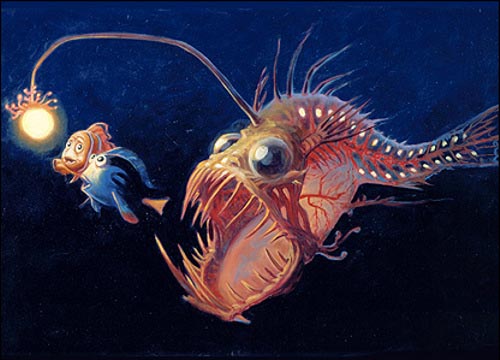From the land, let's move on to the pitch dark sea. In the dark, many water creatures seek out for the light. However, unbeknown to them, they are courting their own death.
Let's take a closer look at this deep sea angler fish. You may find it familiar as you may have seen from the movie, Finding Nemo.
A look at the last meal of the anglerfish. Take note of the size of the prey:
The angler fish shown below has a stalk on its head that emits light. The light attracts prey for the angler fish to eat.
Let's take a closer look at this deep sea angler fish. You may find it familiar as you may have seen from the movie, Finding Nemo.
Anglerfish Adaptations:
- Light-emitting structure - Structural adaptation to attract prey so as to catch it
- Waving light-emitting structure - Behavioural adaptation to attract prey so as to catch it
- Many sharp jagged-teeth that are angled inwards - Structural adaptation to catch hold of prey easily and preventing them from escaping ¹
- Extended jawline - Structural adaptation to swallow prey easily
- Expandable Stomach - Structural adaptation to feed on prey bigger than itself and stock up food in the food-scare dark waters ¹
- Special sense organ - Structural adaptation to look for mate and reproduce
- Male anglerfish attach himself to female anglerfish: Behavioural adaptation for reproduction
A look at the last meal of the anglerfish. Take note of the size of the prey:
P
Primary 6 Science Application Question: Adaptation
The following table shows the conditions at different depths in the ocean.|
Ocean Zone
|
Depth (m)
|
Conditions
|
|
Sunlit zone
|
0 - 200
|
Warm and
bright
|
|
Twilight zone
|
200 - 1000
|
Cold
and dim
|
|
Dark zone
|
1000 – 4000
|
Very cold and dark
|
|
Abyss
|
4000 – 6000
|
Very cold and pitch dark
|
The angler fish shown below has a stalk on its head that emits light. The light attracts prey for the angler fish to eat.
From the information, what is the minimum depth at
which the angler fish would be expected to live? Provide a reason to support your
answer. (2m)
ANSWER TO BE UPLOADED SOON! :) STAY TUNED

The benefits of Singapore Maths education are manifold. Not only does it equip students with strong mathematical skills, but it also fosters critical thinking, logical reasoning, and perseverance in problem-solving. By promoting a deep understanding of mathematical concepts, rather than relying solely on algorithms, students develop a solid foundation that enables them to tackle diverse mathematical challenges with confidence and creativity.
ReplyDeleteRead more: Singapore Maths